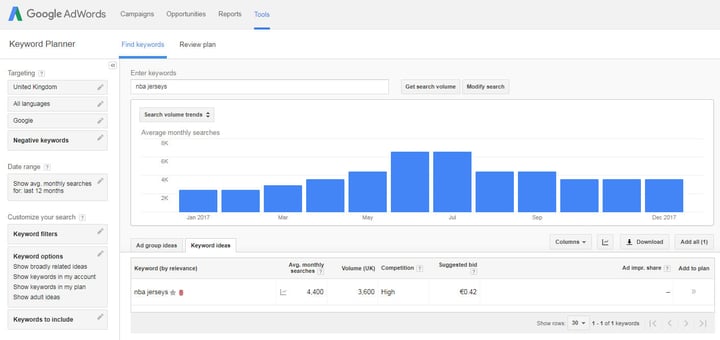SEO Tips for E-commerce: Improve Your Online Shop's Ranking in Google
SEO is an important tool for e-commerce businesses to bring in new customers. Here are the best tips for your online shop to rank higher in Google.

Running an online shop can be a lot of work and one of the toughest parts of the job is figuring out which new products to add to your offer. The biggest question you’ll ask yourself when considering this is, of course, “Will this product sell?” In other words, you’re wondering if there is enough demand for this product to justify the investment in stocking and marketing this product.
In today’s blog, we’ll be looking at some methods to test a product’s demand in order to make your decision process easier.
Surprise, surprise: Google is going to be your first stop when testing out a product’s demand. All joking aside, there are a few things you can do with Google to test out what product might be a hit and what might be a dud.
Let’s start with Google’s Keyword Planner. If you have a Google Ads account, you’re probably already used to this tool.
With the Keyword Planner, you can check the search volumes of the keywords you think would be most associated with the product you’re considering selling. Additionally, you can even get suggestions for other keywords and search terms related to the item you want to sell.
Knowing a product's search volume can provide great insights to a product's demand.
Keyword Planner lets you search for new keywords, get volume data, and more.
Google changed their policy a while back regarding who can access this tool. Now, only Google Ads accounts have access to the Keyword Planner. However, there are other options out there.
For example, kwfinder is a great (paid) tool for seeing search volumes, but will also show you how difficult it is to rank for this search term. Note: They usually have free trials for new users. Give it a shot!
Though it lacks a shiny interface, and their name could probably (definitely) use some work, Keyword Shitter is a great free tool to use for finding similar search terms as well as monthly search volumes and a suggested bid range for your ads.

With Google's Keyword Planner, you can see what times of year these search terms perform best, the search volume, and even the suggested bid for this keyword.
Google Trends is another tool provided by Google that can give you insights into keyword searches. Thankfully, this tool is free for anyone to use. With this tool, you can get insights into the search history of certain keywords and search terms.
This can be very useful for finding new trends on the rise. A steady incline should tell you that something is trending up and very well could be worth investing in. Additionally, this can also give you great insights for seasonal products. It can let you know when people start searching for certain products leading up to seasonal events.
Searches for “NFL jerseys” peak around the beginning and the end of the season in the UK.
(Click on image to enlarge)
Another good way to gauge the interest of a certain product is to see if anyone else is selling it or a similar product. Check their sites. Read their blog. See if they have any product reviews for the item. Generally speaking, where there are reviews, there are customers (unless they’re fake reviews).

Shutterstock/Monkey Business Images
Another strategy when it comes to testing a product’s demand is to actually run an ad campaign for the product. Whether you use Google or Facebook ads, you’ll have to create a landing page or product page for the product.
When a customer tries to add the product to their basket, you can inform them that you are out of stock.
After you've run those ads for a little while, you’ll have some statistics on how much demand there is for this product. If you have experience with online advertising, you should be able to figure out relatively quickly if the ads are working and if the product is actually in demand.
With these visitors on your site, you can also retarget to them later on if you eventually decide to actually sell the product.
If the above-mentioned method seems a bit misleading, you can also try dropshipping this item temporarily. A "white label" dropshipper can send out products on your behalf from their warehouse, but will send the package with your name and logo.

Shutterstock/FOTOGRIN
Because dropshipping often means that your shipments take much longer to arrive, you should make sure you highlight the long waiting time for your product, lest you disappoint your customers and risk getting negative reviews.
Alternatively, you could even order a small number of the items from these dropshipping wholesalers. Store them locally to avoid making your customers wait too long for your new product.
When ordering your items from wholesalers, make sure you get the costs for ordering larger quantities to help you calculate your profits if you indeed decide to add this to your product line permanently.

Shutterstock/stoatphoto
Emails can also help you immensely here. If you have an email list, try taking a survey from some of your past/repeat customers. Ask them whether they’d be interested in such a product. If you find that you’re not getting enough responses, try offering a discount coupon for their opinions.
Some say that the ultimate test for a product’s demand is by using a crowdfunding platform. If you’ve never heard of companies like Kickstarter, you should check them out. There are some really interesting ideas there.
Basically, Kickstarter is a platform to get inventions off the ground. People with a “great” idea can create a video showcasing their prototypes along with a description of their idea and have people(i.e. the public) fund them in order to help with production and development costs. In exchange for different levels of “donations”, the donors will receive either first editions of the final product or other prizes/rewards.
With many of these projects successfully reaching tens of thousands of dollars to develop their ideas, consumers are, in essence, proving the demand for your idea by paying for it before it has even been produced.
Recommended reading:
Starting an Online Shop: A Beginner's Guide
Adding new products to your online shop is always a challenging decision to reach. Remember that finding items that complement your existing product line is usually a good idea from an upselling perspective. However, at the end of the day, don’t risk ordering large quantities of an item before you know that they’ll be in demand. If you test them out first, you’re a lot less likely to regret such a big decision.
30/01/18SEO is an important tool for e-commerce businesses to bring in new customers. Here are the best tips for your online shop to rank higher in Google.
Valentine's Day has grown in popularity across Europe. We're sharing some romantic statistics (redundant, right?) and look at 9 marketing tips for V-day.